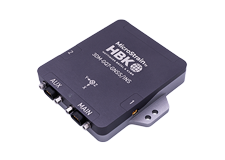Author:
Publication:
- RFID Journal
 The National Aeronautics and Space Administration (NASA) is employing radio frequency identification to capture data regarding vibration, as well as gauge the acoustic emissions that cause that vibration, during space shuttle and rocket launches at Florida's Kennedy Space Center (KSC) and Cape Canaveral Air Force Station, located at Patrick Air Force Base. The solution, provided by wireless sensor company MicroStrain, consists of active 2.4 GHz RFID tags with built-in sensors that capture the vibrations resulting at different areas surrounding a launch pad during liftoff. NASA can use that data to gain greater understanding of the sound waves emitted from launches, and better predict any potential damage that sound waves might cause to equipment and structures within the area. In the future, the space agency may also place tags with strain sensors on fuel containers, or on the treads of giant tractors known as crawler transporters that move rockets to a launch pad.
The National Aeronautics and Space Administration (NASA) is employing radio frequency identification to capture data regarding vibration, as well as gauge the acoustic emissions that cause that vibration, during space shuttle and rocket launches at Florida's Kennedy Space Center (KSC) and Cape Canaveral Air Force Station, located at Patrick Air Force Base. The solution, provided by wireless sensor company MicroStrain, consists of active 2.4 GHz RFID tags with built-in sensors that capture the vibrations resulting at different areas surrounding a launch pad during liftoff. NASA can use that data to gain greater understanding of the sound waves emitted from launches, and better predict any potential damage that sound waves might cause to equipment and structures within the area. In the future, the space agency may also place tags with strain sensors on fuel containers, or on the treads of giant tractors known as crawler transporters that move rockets to a launch pad.
NASA aerospace engineers Rudy Werlink and Ravi Margasahayam first tested the wireless system earlier this year, when space shuttles were launched for the last time at Kennedy Space Center, though the two men continue to utilize the system at Cape Canaveral, where U.S. Department of Defense rocket launches are regularly scheduled.
For decades, NASA has been monitoring the levels of sound, vibration and accumulated stress that can result from rocket launches. The sound from rocket exhaust as it mixes with ambient air can be difficult to predict, Margasahayam explains, and the amount of strain that the resulting vibration places on nearby structures can accumulate to the point that damage can potentially occur. "The idea is to make the ground equipment and structures safe, reliable and operational," he says. However, the large quantity of structures and equipment, spread out across many acres of land, make this a difficult endeavor.
Researchers can not be present themselves for testing, since liftoff can be hazardous. Thus, sensors must be used. NASA engineers are limited as to where they can mount the sensors, especially in the case of wired sensors. "We can't put sensors every place we want," Margasahayam says. For one thing, he notes, wires can be damaged due to the extreme conditions of a rocket launch. In addition, long wire runs can affect data quality. The Florida launching sites pose not only mechanical hazards, from the launches themselves), but also environmental. Wires attached to camera equipment used by members of the press, for example, have been attacked by alligators.
With the wireless MicroStrain solution, the sensors could be placed practically anywhere, to then transmit information to a data-collection base station within a building that has a good line of sight to the sensors, in order to maximize the system's read range. Although each sensor has a built-in battery, the engineers chose to link the tag to additional batteries, via a short wire, to increase its service life. A reader wired to a PC loaded with MicroStrain software can collect and store that information. The data can also be forwarded to a Web-based server known as SensorCloud, via an Ethernet connection—though NASA is not currently using the Ethernet connection, but rather is storing data with the MicroStrain software and uploading it once the secured area can again be accessed following a launch, after which the results can be analyzed.










